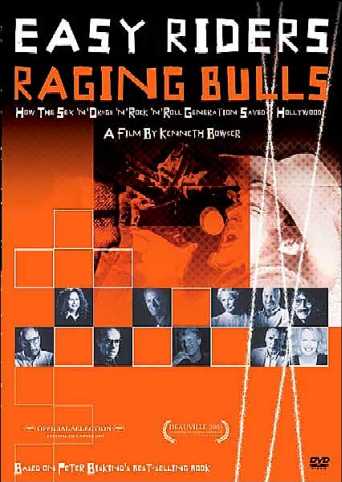

Reviews of Recent Independent, Foreign, & Documentary Films in Theaters and DVD/Home Video
Directed by: Kenneth Bowser. Produced by: Kenneth Bowser & Rachel Talbot. Written by: Kenneth Bowser, based on the book by Peter Biskind. Director of Photography: Paul Mailman. Edited by: Pascal Akesson. Released by: Shout! Factory. Country of Origin: USA. 119 min. Not Rated. With: Peter Bart, Karen Black, Peter Bogdanovich, Ellen Burstyn, Dennis Hopper, Richard Dreyfuss, Margot Kidder & Paul Schrader. Narrated by William H. Macy. DVD Features: Bonus disc of "More Sex, Drugs, and Rock & Roll," including mini-documentaries "The Times," "Sex and Drugs," "United Artists and Midnight Cowboy," "The Film Critics," "Robert Altman: A Director's Style," "Hal Ashby: The Homeless Spirit," "Peter Bogdanovich: The Man Who Loved the Movies," "Francis Ford Coppola: Director's Journey," "Dennis Hopper: Actor as Director," "George Lucas: A Galaxy Far, Far Away," "Sam Peckinpah: Sensitive Excess," "Martin Scorsese: Talent Finding the Edge," "Steven Spielberg: Innocent Savant," "The Participants Strike Back," & "The Author: Peter Biskind."
The problem with turning Biskind's sprawling piece of journalism into a two-hour documentary
is the result cannot help but feel like a gloss on the work's subject: the New Hollywood of the late
1960s and the 1970s. Try as director Bowser might, those viewers who have read the book will
feel that - at a minimum - a 10-part documentary would have sufficed. As is, the 2003 movie
perfunctorily communicates transitions from the critically and commercially irrelevant Hollywood studio system to the New Hollywood, which included not only the mainstream
popularity of offbeat films, but also the rise of blockbusters.
Though the opening sequence - with credit titles consisting of the names from the titular
generation - gives the impression that the period's major filmmakers are to be interviewed, the
fact is only a handful of them appear in the movie. In this way, many insightfully gossip-filled
anecdotes are, if not missing from the film, then told by secondary participants, such as Margot
Kidder (who supplies much of the dirt on the second wave of film-school directors, such as
Steven Spielberg and Brian De Palma), as opposed to primary sources interviewed by Biskind.
The viewer is also not privy to the event of iconoclastic director Hal Ashby's funeral, which
concludes the book wistfully and conveys though the era's end was tragic, the period was
doomed from the start. Rather, the documentary finishes its trajectory off with Scorsese's
triumphant Raging Bull (1980). Though the film may be of interest to those
unfamiliar with the period, the informed viewer cannot help but be baffled as to why Bowser did
not include the elements that were so significant to the book's appeal. As a result, the movie does
not substantially analyze the developments within the industry or cohesively unify them. Instead, one is liable to mistakenly believe all of the factors involved arose by chance. This
differs greatly from the book, which depicts the studios, from the outset, as quite cannily
targeting the youth demographic who loved the New Hollywood's innovative techniques and
content. DVD Extras: The features are illuminating insofar as
they put much of the otherwise bland documentary in perspective - including perhaps why it
turned out to be so innocuous. First among the highlights are the interviews of film
critic Andrew Sarris and cinematographer Gordon Willis (The Godfather, 1972). Sarris,
with his articulation for American audiences of the French New Wave's auteur theory, may have
had as much to do as any the era’s filmmakers with the European sensibility that influenced its
movies. Willis describes how much Marlon Brando is responsible for The Godfather's lighting
design - thereby stressing the collaborative nature of filmmaking. A segment on Altman,
however, omits comments in the book reporting on his darker side, such as his mimicking actress
Louise Fletcher's use of sign language during the Oscars that took place after their mutual
falling-out due to his giving Lily Tomlin the role Fletcher had created, based on her deaf parents,
for 1975's Nashville. In "The Participants
Strike Back," most notable is how Joan Tewkesbury (screenwriter of Nashville) forgets
the book's title and faults it for not adequately expressing the sense of humor and fun - as
opposed to its minute recounting of enslaving drug addictions - that were also allegedly part of
that time. Dennis Hopper, Peter Bart, and Paul Schrader seem to strongly object to the book's
portrayal as well. It makes one wonder how the filmmakers got these people to even be
interviewed for a project based on Biskind's work: did Bowser agree not to challenge too much
their version of events, and to eliminate some of what Biskind had written about? Related to this,
there is a conversation with Biskind, who goes into how he got access to many of the book's
major figures (but does not explain why they are not in the movie), and which is remarkable for
how well the reporter feigns shock that, in the aftermath of his book, most of Tinseltown hated
him. Reymond Levy
|